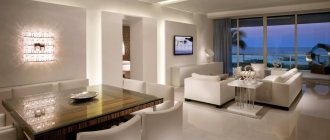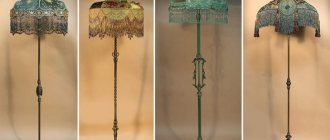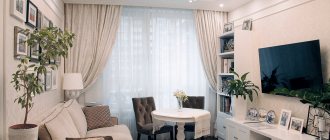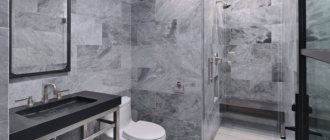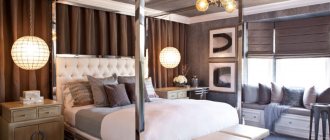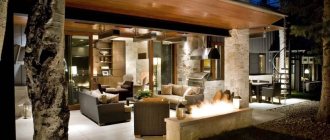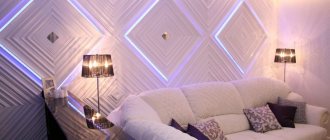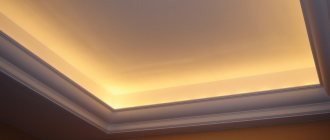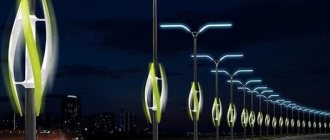Just as a theater begins with a wardrobe, an apartment begins with an entrance hall or corridor. This is where a person gets his first impression of the apartment when he enters the house. That’s why it’s so important to correctly design the lighting in the hallway of an apartment. The hallway, as a rule, does not have a large area, and the interior designer cannot turn around here. Therefore, light in the corridor and hallway can often be the only way of self-expression.
Hallways can be very different in configuration - spacious square, long narrow corridors, semicircular or a small hall that turns into a long passage to other rooms.
Rules for organizing lighting
The main feature of a typical hallway is the absence of windows. There are exceptions, but generally there are no windows. This means that at night the room can be completely dark, and during the day there will be practically no lighting either. This means there should be a lot of light there so that it doesn’t look gloomy.
If the room is winding, has several bends or turns, you need to take this into account and arrange the lamps in such a way that there are no dark unlit areas.
If there are niches and built-in cabinets, their visibility and illumination should be taken into account when placing lamps. You may need to add light to the niches.
At night, it is not very pleasant to turn on the “big” light, and since the corridor is used as a passage room, it is not always needed. It is advisable to provide two types of lighting - night (muted) and daylight, bright.
Tips for organizing a meeting
Office lighting
Since the duty meeting is used not only in industrial buildings, but also in most public buildings, the choice of lamps is best made taking into account these simple recommendations:
- determination of lighting level standards for a specific room;
- the lighting device must fully meet the requirements of this type of room. So, for hospitals and offices these requirements will be diametrically different;
- the need for the lamp to have or not have moisture-proof properties, as well as a metal casing to protect against various types of mechanical damage.
It should be remembered that installation of such devices can be carried out both in special niches in the wall, and with the help of fasteners on the surface of the walls. Emergency lighting is an integral part of the lighting system in most public buildings and requires mandatory compliance with the relevant standards in its organization.
Sources of light
Before installing lighting, you need to figure out which lighting fixtures are best suited for a particular room.
Spotlights
Obviously, a chandelier is not always a suitable solution for a small room. In a compact space, the lamps should be compact. Therefore, one of the popular lighting options are spotlights.
Such light sources may not be very powerful, so it is desirable that they provide diffused light and there are several of them. You can place it either in the center of the hallway or closer to the walls, or you can arrange it in the shape of a zigzag or arc.
Neon lamps and flexible neon
Neon lighting was especially popular in the 1980s, and now it has been given a second life. Now a neon lamp is an interesting design move that can be used as additional lighting.
The lamp itself is a tube filled with gas that produces colored light. The tube can be hidden and get the effect of hidden lighting. In cases where it is necessary to highlight a curved surface, flexible neon can be used.
LED strips
LED strips are economical, safe lamps that can be placed along any trajectory. They come in warm and cool shades, as well as colored ones. Most often, tapes are used as curtain lighting or illumination of a multi-level ceiling.
Since the LED strip consists of small, bright bulbs, it should not be placed in front of a reflective surface, otherwise you will have to use a diffuser.
If this is not done, the reflection from the hidden light bulbs will be visible, and this is unsightly, because the effect of such illumination is to hide the light source.
LED duralight
LED duralight is a kind of light cord. This is a hollow polyvinyl chloride tube into which LED bulbs are soldered. It can be cut and bent. The lighting can be any color, and the tube itself can be transparent or frosted.
Light floor
A light floor is a very unique way to decorate a room in a hallway. These are square LED modules that are mounted on the floor. They can be arranged in the form of a pattern or designed as a path - it will look original, although this type of lighting is rarely used in the interior of an apartment.
Light design
In addition to improving the operating conditions of various buildings and structures, lighting systems can also improve the visual characteristics of the interior of any residential building or apartment. Due to such a high importance of lighting systems in human life, today when carrying out electrical installation work it is customary to pay special attention to high-quality light design, in particular, in modern apartments it is rare to find rooms in which the only source of lighting is an ordinary ceiling chandelier; now it will be supplemented decorative and zonal light sources.
All lighting for an apartment can be divided into local and general. If experienced designers are involved in the design process of lighting systems, they will most likely design the system in such a way that all the light is correctly distributed across levels, as in nature, that is, the ceiling will receive the most light, and the floor will receive the least amount of light.
Currently, the market offers a huge number of different devices for organizing local lighting in apartments and private houses. Among the most popular lighting devices among residents are sconces, recessed and pendant lamps on walls, floor lamps, etc. For general lighting, chandeliers and various built-in ceiling lights are usually used. When drawing up a project for the power supply of a restaurant or other buildings, and choosing light sources, it is imperative to take into account the specifics of each individual room, its purpose, features and other parameters, on which the requirements for light in a separate room will depend.
Hallway lighting
The importance of competent design of electrical equipment in the hallway is often underestimated by many owners, but in vain. This is the first room into which any person entering the apartment, be it its owner, tenant or guest, enters. The lighting system in this room will determine the first impression of the apartment, and sometimes of its owners.
Speaking about what the lighting in the hallway should be like, first of all, it should be noted that the light here should be bright enough, since usually there are no natural light sources in such rooms. In cases where a chandelier acts as a source of general lighting, special attention should be paid to the height of its location. It is important to consider that the chandelier should not be too large and massive and should not create inconvenience during the process of dressing and undressing.
It is recommended to install local light sources near the mirror location. Such zonal lighting devices can be, for example, two identical lamps placed on both sides of the mirror at a level of 160-180 cm above floor level. The main condition when choosing lighting devices is that they should not create glare.
Light in the living room
When considering apartment lighting options, you should dwell in detail on the rules for organizing light in the living room. The most common option for organizing general lighting in such rooms is using one pendant chandelier in the center of the room or using several built-in lamps along the perimeter of the ceiling.
Arranging local lighting in living rooms is much more difficult. First of all, designers will need to take into account the main purpose of this room. If a recreation area is organized in the room, then when building a lighting system you will need to install a certain number of wall lamps, as well as floor lamps next to armchairs and sofas. There must be a small table lamp on the coffee table.
It is best to install several separate light sources in the living room with varying degrees of brightness, so that different levels of light can be turned on for different occasions.
Light in the kitchen
When organizing modern apartment lighting, special attention should be paid to the kitchen. Here you should definitely install not only general lighting devices, but also additional lighting for the work group - next to the dining table, stove and in other areas.
The general light source should be located above head level, and it is desirable that the device creates a light that is not too bright, non-dazzle, which could interfere with the cooking process.
Below you can use the online calculator to calculate the cost of electrical installation work.
Online design cost calculation
Types of lighting
Below are the main types of lighting used for hallways.
Basics
The main lighting is the main one that will dominate the entire room. A large pompous chandelier is unlikely to be suitable, although this option is also possible with a high ceiling - these can be spotlights installed in a row or along the perimeter, or local ones distributed along the entire length of the corridor. You can make larger accent lamps and complement them with smaller ones.
A very nice option is hidden lighting.
It is usually done around the perimeter of the room and can be implemented in one of three options:
- light from the ceiling to the wall;
- light from the cornice on the ceiling;
- the light of their ceiling niche.
When implementing the first option, a niche is made between the suspended ceiling and the wall, where sources are built in to illuminate the wall.
In the version of eaves lighting, a decorative cornice is attached to the wall under the ceiling, and lamps are built into it - then the hidden diffused light is directed to the ceiling.
In the case of a ceiling light, a structure of the desired configuration is built from a niche, and LED strips are usually built into it.
The main advantage of floodlights is directionality. If they are positioned correctly, you can locally direct bright light onto the walls. The beams can be rotated, thereby changing the nature of the lighting. Most often, spotlights are used in loft style.
Spotlights can also be used in an apartment designed in a classic style - they are universal sources that create the right accents in the room. A straight, long corridor will not seem so linear and monotonous if the light spots are distributed non-uniformly with the help of spotlights.
Local lighting
Local lighting helps make the hallway more comfortable, divide it into zones, and focus attention on a specific design element. These are sconces of various kinds, floor lamps, lighting for paintings, mirrors and niches.
Garlands are also suitable for decorating local lighting.
Additional
Additional lighting is also good when you don’t want to turn on the “big” light in the corridor and hallway. It will most likely be purely decorative, but can be used as a night light, depending on its power. This can be floor lighting, baseboard lighting, or hidden lighting mounted in the ceiling, floor or walls; again, sconces, floor lamps, small chandeliers that provide soft, muted light.
Hidden lighting can be implemented not only in the ceiling, but also in the wall and floor: a lamp is placed behind a specially constructed structure - a very good decorative effect is obtained.
Dim additional lighting can be made colored.
Hallway lighting with plasterboard ceiling
For such ceilings in the hallway, any lighting options are appropriate. However, pendant lamps and chandeliers must be mounted under a metal profile or a special dowel.
Due to their characteristics, plasterboard ceilings practically do not reflect rays. But you can create spectacular hidden lighting for the corridor by placing shelves with lighting fixtures in the lower box of the structure. You will get stunning light lines with soft, unobtrusive radiation. It is not necessary to make them even - if there are decorative elements on the ceiling, the stripes can follow their contour. The photo shows a vivid example of the implementation of such a lighting project.
Lighting a plasterboard ceiling in a hallway
Selected lighting options
The choice of lamps, in addition to the room configuration and interior style, may depend on the type of ceiling. The first thing to consider is its height and material.
A high ceiling will allow you to create multi-level structures with built-in lamps. They are not very fashionable now, but they can look organic.
If the ceiling is not low, it is appropriate to hang a chandelier or pendant lamp on it.
If the ceiling is not very high, no more than 2600 mm, you will have to limit yourself to built-in or overhead lamps, hidden lighting or even one wall lamp.
Stretch ceiling
When using a stretch ceiling, you should keep in mind that the film cannot withstand overheating, therefore, when building in ceiling lights, you need to take into account their characteristics. Typically, lamps no more powerful than 35 watts are suitable. But you can make a lot of them - they will look like little stars.
An interesting solution is a luminous stretch ceiling. In this case, lamps are hidden behind the film and it seems that the entire surface of the ceiling is glowing. It can be made monochromatic or applied with an image.
Plasterboard ceiling
When using drywall, you can use any lamps you like, make hidden lighting, or install spotlights. In addition, this material allows you to make structures of almost any shape, as well as combine it with other materials, for example, using a stretch ceiling element.
Floor and walls
Everyone knows that lighting can be placed not only on the ceiling. This usually refers to additional light. When they talk about walls, they often mean illumination of niches and paintings, photographs, decorative compositions that can be beautifully illuminated and draw attention to them. This looks great in a classic interior.
For a more modern design, you can build an original furniture structure, which will not only make the corridor unique, but will also be an unusual source of lighting.
The floor can also be illuminated. To do this, point light sources or an LED strip are mounted directly into it or into the baseboard.
Mirror lighting
A mirror is an integral element in the interior of a hallway. When leaving the house, you want to see yourself in the mirror, and when entering an apartment, it’s rare that a person doesn’t look at it. Therefore, you need to take care of the lighting of this important item in the room.
A mirror is often highlighted by sconces - on the sides of it or even on the mirror itself.
You can use the built-in lighting behind the mirror. In this case, lighting fixtures are installed in the gap between it and the wall.
There are mirrors on sale with built-in lighting - around the perimeter or with a pattern.
The pattern can be chosen from those offered by the supplier or made exclusive to order.
Lighting at night
Today, night lighting of the corridor is very common. It should not blind your eyes - just provide a soft, muted light, which is enough to not feel like you are in the dark. Such lighting does not interfere and does not illuminate the rest of the rooms at night if the apartment has glass doors or they are left open.
In this case, many use built-in wall lighting and additional decorative elements using it.
Niche lighting is one of the options for night lighting.
Wall decorative elements with LED lighting do not dazzle, decorate, and look original.
A low power curtain light can also serve as a night lighting option. If you install a dimmer, you can control the brightness, then it can be both night and day, depending on the settings.
Dim sconces with directional light or even spotlights are also suitable for illuminating the passage area at night. It is desirable that the light be warm.
Lamps built into the floor and directed towards the walls can, in addition to their utilitarian purpose, serve a decorative role and enhance the impression of a textured wall.
Floor lamps must be flat and waterproof so as not to damage them when washing the floors and to avoid tripping.
The most popular is floor lighting in the hallway, running along the baseboard, or built into the walls along the floor.
You can embed an LED strip into the print by hiding it behind the diffuser.
Requirements for floor lighting sources
Before you purchase lighting equipment and begin installation, you need to find out the basic requirements for individual elements:
- All lighting fixtures, wiring and connectors must be highly moisture resistant. The average degree of protection for lamps is IP65, the highest level is IP68; such structures can be installed in underwater pools. These requirements are especially important when lighting the floor in the corridor, bathroom and other rooms with high humidity.
- Lamp housings must not only be sealed, but also durable and resistant to mechanical shock.
- To illuminate the floor in an apartment, you should not choose very powerful lamps so that they do not blind your eyes.
- Lamps for illumination are selected so that the lighting is bright enough and consumes a minimum amount of electricity.
- Lamps with minimal heating, LED light sources are an ideal option for this case.
Nuances of lighting rooms of different shapes
Obviously, the brighter the room, the more spacious it seems. Therefore, in the case of a small hallway, you should avoid dark colors and dim lamps. It is advisable to add more light - it should be as bright and warm as possible, this will add comfort. Decorative lighting wouldn't hurt either, if there's room for it.
A long corridor allows you to vary lighting options. You can use several ceiling lights or combine several ceiling lighting options along the length of the room.
A long corridor will most likely have niches, decorative elements, paintings, and to diversify it, you can place various accents in the form of additional decorative lighting for these elements.
In a long corridor, it wouldn’t be a bad idea to install not just a simple switch, but two transition switches - one installed at the entrance, the other at the end of the corridor, so that you don’t have to return to the front door to turn the lights off and on.
A corridor with a complex layout - square with a branch, L- and T-shaped - is interesting to the designer because extensions and branches can be used in different ways. For example, decorate a square one as a hall, hanging a chandelier there, and a branch with additional decorative lighting.
Features of the room
Light at industrial facilities or public buildings operating around the clock plays an important role not only for the high-quality production of any product, but also for maintaining people’s performance at an acceptable level. Lighting standards developed for these purposes presuppose the safe activities of workers during day and night shifts.
Note! The standards specified in SNiP regarding the level of illumination for each specific case are the cornerstones of the correct organization of the labor process, as well as labor protection.
Artificial light in production
A lamp installed in a production room must meet the following requirements:
- provide even and sufficient lighting (standards for each room are prescribed in SNiP);
- functionality. Emergency or emergency lighting will have different implementations through lighting fixtures;
- providing conditions for an optimal work process;
- reducing visual fatigue of people during important production processes, as well as reducing the number of potential situations that could lead to injury or death.
All these requirements apply to absolutely all types of lighting, and they must be taken into account at the design stage of industrial facilities. Today, for industrial premises and public buildings (schools, hospitals, etc.), in addition to the two main types of lighting (artificial and natural), there are additional lighting options:
- working;
- emergency;
- duty;
- security.
Emergency lighting, like all other types, refers to the artificial type of space illumination. Let's take a closer look at what it is.
Lighting control methods
In addition to the usual switch, you can install transitional switches to turn the light on and off from different points - this option is suitable for long and voluminous walk-through rooms.
It is very convenient to install a switch with a motion sensor in the hallway. In this case, the light will turn on itself when a person appears in the hallway’s visibility zone, and will turn off when he moves away. This option will also help save energy if not all residents like to turn off the lights behind them.
You can install a dimmer to adjust the brightness of the lighting.
Dimmers are:
- mechanical - with a rotary knob that adjusts the brightness in the same way as adjusting the volume;
- electronic, push-button - it can be used both as a regulator and as a switch, pressing buttons and selecting different operating modes;
- touch - with a touch panel to implement functions;
- remote - controlled via a remote control.
Some of them work in such a way that when the brightness of the lamps is reduced, the energy consumption of the light bulbs is reduced; for others, this function is not available. You can read about this in the technical description of the device.
Recommendations and possible errors
To avoid design mistakes, it is best, of course, to trust a professional. If you decide not to contact a designer, it is advisable to take into account some nuances when decorating the room.
What you need to consider when organizing and installing lighting in the hallway:
- It is better not to install cold light lamps if the interior does not intentionally involve its use. Cold light is uncomfortable and most people associate it with hospitals and other public institutions.
- If you have a long narrow corridor, you need to try to organize several zones and designate them with color, light or finishing material.
- For a hallway with a double door, it is advisable to provide additional lighting between the doors.
- When installing directional light (spotlights, some spotlights), you need to check that the light does not blind your eyes when entering the room.
- When installing floor lamps, you need to keep in mind that they must be waterproof so that they do not get damaged when washing the floors.
- When installing a motion sensor, it is advisable to configure it in accordance with the composition of the family. If there are children in the apartment, so that he reacts to them and does not respond to pets that accidentally enter the hallway.
- You should not use very bulky lamps in the hallway if this is not required by the design features of the room, because large objects visually make an already small room smaller.
The hallway is the “face” of the owners, creating the mood when entering the apartment. When thinking about what impression it should give, it is advisable to imagine the entire apartment as a whole, its style, and then use it for decoration.
